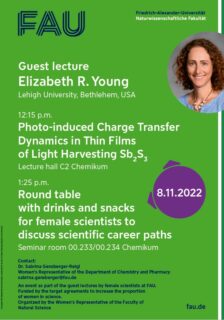Guest lecture on Nov. 8th, 2022: “Photo-induced Charge Transfer Dynamics in Thin Films of Light Harvesting Sb2S3”
Guest lecture: 08.11.2022 – 12.15p.m. – On site
Elizabeth R. Young – Lehigh University, Bethlehem, USA: „Photo-induced Charge Transfer Dynamics in Thin Films of Light Harvesting Sb2S3“
Solar light harvesting and interconversion of solar energy into either electricity or driving force for small molecule activation reactions are critical to the production of energy that our society requires to function. At its most basic, these energy conversion processes are driven by charge transfer. Therefore, to understand these chemical processes, fundamental, mechanistic understanding of electron transfer is critically important in order to connect molecular structure with chemical reactivity or material interactions at interfaces with device performance.
As chemists, we are in a unique position to address fundamental questions associated with charge transport by designing and studying relevant molecular and materials systems. One of the Young Lab’s long-term goals is to generate a comprehensive set of kinetics measurements on carefully designed and fabricated materials systems that will allow us to connect structure and function with device performance.
Towards this end, I will discuss our recent work on stibnite (Sb2S3), which is employed as the photo-active layer in next generation thin-film solar cells. Sb2S3 is of particular interest due to the suitable band gap of 1.7 eV and high absorption coefficient (1.8 × 105 cm–1 at 450 nm). I will present our work using transient absorption spectroscopy to directly observe carrier diffusion, electron transfer, hole transfer and charge recombination through uniform ultra-thin (< 3 nm) layers of insulating or transport materials deposited by atomic layer deposition (ALD) that are coupled to photo-active materials. Our results reveal how the structure and function of materials and their thickness directly impact the operation of the completed solar cell.
I will describe our path forward in these efforts that will allow us to understand the mechanism of photo-induced charge transfer in completed devices, both photovoltaic and photoelectrochemical. Such measurements are critical to characterize how photo-induced dynamics change when kinetics are recorded on devices under the operating conditions, i.e. applied potential (in situ) and applied potential plus steady-state illumination (operando) conditions.
Download:
Roundtable: 08.11.2022 – 1:25 p.m. – On site
With drinks and snacks for female scientists to discuss scientific career paths
Elizabeth R. Young grew up in eastern Pennsylvania. She attended Haverford College as an undergraduate where she majored in Chemistry and minored in German, while also playing intercollegiate soccer and squash. As an undergraduate researcher, Liz worked in with Prof. Julio de Paula on porphyrin-peptide nano-wires – during which time her love of photochemistry and spectroscopy was ignited. After completing her undergraduate studies, Liz spent a year abroad in Germany as a participant in the Congress-Bundestag Youth Exchange for Young Professionals. While in Germany, Liz learned about the German culture and language while working in the biophysical laboratory of Prof. Dr. Joachim Spatz at the University of Heidelberg. Upon returning to the U.S., she attended graduate school at the Massachusetts Institute of Technology earning a Ph.D. in Physical Chemistry. Her work in the laboratory of Prof. Daniel G. Nocera focused on photo-induced charge transfer coupled to proton motions in small-molecule donor-acceptor systems. Liz then spent two years as an NSF ACC-F post-doctoral fellow in the electrical engineering laboratory of Prof. Vladimir Bulovic at MIT learning about charge transfer in organic semiconductor devices.
In 2011, Liz began her independent career working with undergraduates at Amherst College. Liz moved back to Pennsylvania in 2017 to Lehigh University where she is currently an Assistant Professor. Her research efforts focus on understanding excited-state charge transfer processes for a range of applications, including excited-state proton-coupled electron transfer reactions in model system and photo-induced charge transfer in materials of interest for next generation photovoltaic devices.
Organized by the women’s representative of the department of Chemistry and Pharmacy: Dr. Sabrina Gensberger
An event as part of the guest lectures by female scientists at FAU.
Funded by the target agreements to increase the proportion of women in science.
